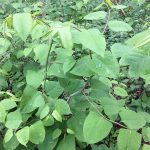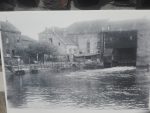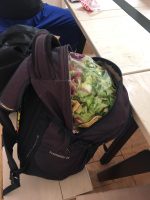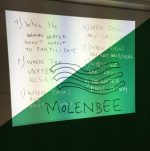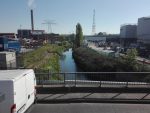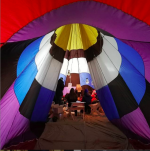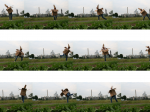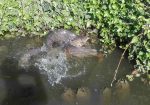Imagining a two-day boat trip on the Dilje-Leuven Canal:
M.M.: A brief introduction into my practice: I see performance as a practice of inhabiting a specific ecosystem. Currently, I am focusing on the oceanic ecosystem, one that can only in part be inhabited by human beings.
Concerning the ocean, the question that interests me most is: What is my relation to the ocean, and how can this relation be described? What are the affects or elements that make it up? And how can those affects be performed and thus communicated? My focus lies on creating affective (an)archives. i.e. archives that communicate relational experiences and knowledges of the ocean.
NG: What makes the ocean for you to the ideal ecosystem to be performatively inhabited?
M.M.: Well, I feel very attracted to it physically and mentally. And it also proposes a different way of thinking and being than land proposes. So I want to explore those. But it is not an "ideal" ecosystem because it is actually quite difficult to inhabit it physically. Very little is known of the ocean compared to ecosystems on land.
C.S.: For me, it is less the ocean than the water that triggers the idea of inhabiting it in a performative sense. Water is everywhere, in us, around us, we are made up of water - and the element is so common that we don't think about it much, as we live our lives. To give it a moment of special attention and to engage with it as a practice is like a process of becoming aware of something that we deal with every day, and that is so at the basis of our existence.
The ocean was extremely attractive to me when I was a child. I used to spend my entire summer holidays at the Mediterranean Sea, and I spent most of these months inside of the water. It was the experience of being submersed, totally enveloped by the salty moving body that intrigued me. The smell, the temperature, the consistency (compared with the bathtub water or the swimming pool water) of the Mediterranean became like a place where I would feel at home for me.
Today, much older, I don't have this urge anymore to submerse in the sea. I'm much more respectful of the gigantic body of water and enjoy more contemplating it by staying at its side, and not going in.
N.G.: Probably, I could see the ocean in any water. Looking deep into the glass before I take a sip of delicious spring water - e.g. at Schwarzsee in the Alps - I see the sea, I see into the history of these molecules and can follow them through my body into my pee, into the ground into the flower, into the sunray into the rain into the river into the stream into the whole flow that cyclically generates life. Of course, on these waves, we perform our lives and are performed by them. In the case of water, the conditions it creates, the landscape it carves, I'm not sure if I inhabit and perform within or if it's not the other way, the water inhabits me and performs through me.
M.M.: I think different bodies of water work differently, affect the human body in a different way. So for me, the ocean as I recently encountered it Portugal, for example, the force that it has, is very different from my own experience of the sea in the Mediterranean in Greece.
C.S.: Can you tell more about the performative aspect that intrigues you with water or the ocean?
M.M.: Performance is for me the way we choose to enter into relation with the body of water that we encounter. So for example, if you say that you want to be engulfed by the sea, the salty and continuously moving water, I am interested to know more about this sensation that you have and how it could be performed now, for example, in the conditions in this room.
C.S.: The most intriguing part that comes to mind at once is the aspect of being carried. And of course, we have this much more on the earth. The earth is solid and carries us all the time - something that we also take for granted, and forget about it, as we sit on this chair.
In the water, especially the salty - thick - water, the buoyancy is a fantastic characteristic that gives me a sense of trust inside this ever-moving deep sea.
M.M.: Yes, I recognize this feeling! What I would propose now on the trip is to explore how this sensation could be reconstructed through performance or how this sensation could influence what you are researching artistically.
C.S.: First association is STAGE DIVING!! But that is not very serious, of course!
M.M.: What is stage diving?
N.G.: The tricky thing might be, that the sensation is part of the ecosystem which should be performed. But probably that's exactly the chance. To perform WITHIN something not ON something (like a stage). If we take performance as a 'doing' not as a 'representing' it becomes very interesting, I think. Performance in an economic sense is an act of domination. To 'perform' witing a system, in respons-able relation to it, is something very different. The notion of being performed while performing is there very applicable.
C.S.: Stage diving is to let yourself be carried by the masses of listeners /audience standing in front of the stage when you dive onto their uplifted hands. It is a big test of trust!
M.M.: Aaaaahh yes, the rockstar thing. We could try it.
CS: Now, I have to think of VariousArtists - whose performance often has to do with experimenting with what he eats, drinks, how much he sleeps, or exercises. So a 40-day water fast could be a very embodied experience of what water does. And very cleansing, as well. Another important aspect of water, of course - the CLEANING!
In that sense, Trudo makes his body the ecosystem and the stage at the same time.
M.M.: We can make a list of those aspects here, during this conversation? I was planning to do this also on the boat trip. Now we can imagine the ocean and that we are travelling on it. What sensation does it give us?
1. Being engulfed/ buoyancy
2. Sense of cleansing
3. ...
C.S.: There is something that happens to the sinuses, also. And to the sense of smell that I find very interesting. In the ocean, of course, you smell the salt and the "sea" - like algae and dead fish and live fish and all the rest of it. But there is also something happening to the nose, in my case. It gets full of water and clogged, and at the same time, it cleans itself.
What aspect of sensation is that?!
M.M.: How would you name it? If you had to use one word? Smell? Or salt-smell?
N.G.: For this, it would have been perfect to be on the boat. I'm sure we would find another answer than here!
C.S.: There is something that is inside and outside at the same time. It is as if the ocean gets INSIDE of my body through the nose. It is the one opening that lets the water in. So, it is not the smell, I think - it is more the permeability of my body to the body of water.
Of course, also the skin gets wrinkled and like a prune, that it keeps the water out. On the contrary, it may even lose a bit of my body water instead of letting the ocean in, because I always get very thirsty when I spend a long time in the water.
M.M.: Permeability is a wonderful word for it! There is this concept of the Hypersea, that was put forth by two biologists, Mark and Dianna McMenamin. They understand all living organisms on land as "lakes" that communicate with each other by on the one hand keeping the water in and on the other being permeable and passing water from one organism to the other. It's as if all organisms on land form a deterritorialized sea that they carry in their bodies.
N.G.: The inside/outside is actually rather a human perspective. Nothing wrong with this, but from the water perspective we are simply a tunnel! A place of passage, and probably of transformation. Perhaps that's the most real performance we do. Being a catalyst for waters. WE ARE THE CANAL!!
C.S.: Now, I have to think of homoeopathic medicine, somehow. The transformation of the water inside our body tunnel.
A tangent.
N.G.: btw. What do you think is the boat a stage ? or rather an ecosystem within an ecosystem?
C.S.: the boat is a very artificial object for me that allows us to traverse the body of water, to be on it without getting wet, to not engage with the water but only with the surface of the water, and there is an aspect of dominance in boats also. You are always (unless you are going under) on top of the water and you don't get wet. It is an object that divides you from the water. You feel it but indirectly only. The most stringent aspect of water - that it is WET - is lost. You don't get wet.
M.M.: You can get very wet on a boat! Have you ever been on a boat when there are strong wind and big waves? You get soaked.
For me, the boat is a machine that allows us to enter into relation with the vastness of the sea, that otherwise, we would not be able to approach. But yes, it also has an aspect of domination. Without boats, no "discoveries", no colonization, but also no communication, no fishing, no trade. It's a complex place to be, the boat. It also makes for a very specific surface on which to move and urges a particular behaviour regarding the human bodies that inhabit it.
N.G.: We have this image of the sailors, that try to master the waters with their boat, fighting against the waves and storms, overcoming the overwhelming forces of nature. Like Ishmael fighting Moby-Dick the wale.
C.S.: I have an aunt who cannot swim. She would go on a boat, though. But she would not go directly into the water. Only where it is very shallow.
And Jonas who found himself inside the whale. How did he end up there again? That was an ecosystem inside of the water, and then he was inside the belly, and that was a bit like land again. Like a membrane that allowed him to be inside the water for a long time, but without touching the water. Was it so?
M.M: So you would prefer a whale belly to a boat?
C.S.: that is difficult to answer. I don't have a clear image of a whale belly...
N.G.: Of course! Even in this nutshell, I dream of the big monsters.
M.M.: So we add 3. permeability, 4. whale-belly...
N.G.: Or let's say permea-belly.
C.S.: And now, the ice. What about ice. Is this ocean? But solid, you can walk on it. And it totally changes the experience of being in/on the water.
Or under it...?
M.M.: Yes definitely, ice is also ocean. Just in a different form. With a whole different set of conditions. I talked to a glaciologist recently, and he said there is the category of sea ice and the ice shelf, that are both ice formations on the sea, which differ from the big glaciers that are usually land formations.
N.G.: For an ice bear it might be something different than for a penguin, or for the wind. For the ice bear it is (more and more ) a boat!
C.S.: With ice I find it confusing. Do I remember right that for a long time it was not known if the North Pole is solid or if the South Pole is solid - land or sea. Ice confuses things a bit, I find...
M.M.: Then lets end in this confusion? I think its quite appropriate.
NG: True!














